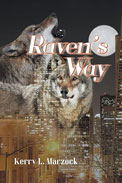
 |
Enter the world of the weregune, a race of shapeshifters that “has lived among humanity since life first began to walk this earth on two legs.” Unlike werewolves, the weregunes—considered “rogue wolves” by shapeshifters—communicate telepathically with their clan, are not ruled by the moon’s cycles, and have a code of ethics. Weregunes do not (usually) kill innocent children or women. Interestingly, they can also drink all the alcohol they want with no ill effects. Marzock humanizes the weregune with details such as their enjoying beer for breakfast. But when Raven’s mate is murdered, perhaps by one of his own, his thirst for revenge reveals this supreme predator in all his weregune glory. Raven leaves his cabin in Maine, where he was nursing his sorrow, to follow leads in Philadelphia, metamorphosizing periodically into terrifying creatures with supernatural abilities. In Philadelphia, Raven meets a human female detective assigned to solve brutal murders by wolflike creatures in the city’s park. She becomes important to Raven’s life and quest.
Marzock renders the shocking, unnatural, and grotesque believable by humanizing Raven and his clan. Weregunes mate for life, can have sex with humans, do not engage in gratuitous violence, and love their parents. The author’s imagination bends the rules of reality but in a believable way via a dark, atmospheric, and poetic tapestry. Readers familiar with Philadelphia will delight in Marzock's references to Fairmount Park, New Hope, and the Schuylkill Expressway, among other locales. Raven’s emotional core of revenge and family loyalty rings true, despite the fact he’s a weregune and not human. Marzock creates a believable world of supernatural shapeshifters who work together according to their rules. Raven’s journey to healing reveals the fascinating lore of weregunes and werewolves while taking readers on a horror ride of deliciously spooky proportions.